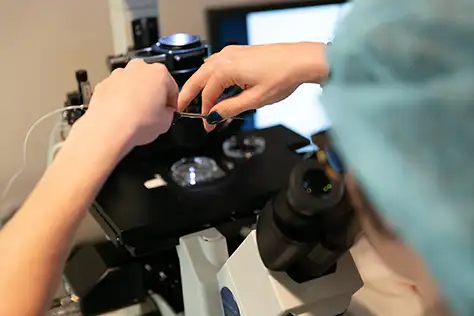PGT - Preimplantation Genetic Testing
Genetic Testing for Embryo Selection
PGT - Preimplantation Genetic Testing

Preimplantation genetic testing (PGT) is a form of genetic testing conducted on embryos. PGT is done during the IVF process. After a woman has undergone an egg retrieval, the eggs are fertilized with a sperm to make an embryo. These embryos are nurtured and grown in the lab until day 5 or 6, also known as the blastocyst stage. When the cell reaches blastocyst, it has approximately 100 – 200 cells. It is then safe to remove (biopsy) a few cells from each embryo. These cells are taken from the outer layer of the blastocyst that develops into the placenta, so the biopsy ideally will not harm the future baby. These biopsied cells are sent to a lab so they can be genetically tested. The embryos are frozen until the results are returned in 7 – 10 days.
Once your results are returned, the next step is to meet with your physician. Sometimes a recommendation to speak to a genetics counselor is made to further discuss the results before meeting with your physician. Your physician will discuss options for embryo transfer or other future treatments. It’s important to note that not all embryos will be genetically normal. The chances of healthy embryos are heavily correlated with age and health history. Your conversations will vary based on the type of genetic test that was performed.
There are three different forms of embryo genetic testing. While one of these genetic tests will ensure the embryo has the correct number of chromosomes (PGT-A), the other two identify which embryos carry a gene for a specific disease (PGT-M and PGT-SR).
PGT-A (formally PGS)
PGT-A is defined as Preimplantation Genetic Testing for Aneuploidy. Previously, this was known as Preimplantation Genetic Screening. Aneuploidy means an abnormal number of chromosomes, therefore this test will look for missing or extra chromosomes in the embryo. Each egg and sperm has 23 chromosomes, but when fertilization occurs, they merge to create an embryo with 46 chromosomes. If one of the chromosomes is missing, or there is an additional one, this can lead to miscarriage or a failed IVF cycle.
Do I Need PGT-A?
Chromosomal abnormalities happen randomly. At age 28, about 25% of your embryos will be genetically abnormal. This number increases to 75% when you are over 40 years of age. This test is recommended for women who have had multiple miscarriages or women over 35. If you are interested in family balancing, PGT-A will also tell you the gender of each embryo.
PGT-M (formally PGD)
PGT-M is defined as Preimplantation Genetic Testing for Monogenic (single gene) diseases, formally known as Preimplantation Genetic Diagnosis. PGT-M is a test created uniquely for each couple. This test looks for a single gene (monogenic) that causes a specific disorder.
Do I Need PGT-M?
Individuals often use this test when they are known carriers or have a family history, and do not want to pass the disorder to their future child. PGT-M examines common disorders such as:
- Cystic fibrosis
- Spinal muscular atrophy
- Sickle cell anemia
- BRCA1 & BRCA2
- Tay-Sachs
- Muscular dystophy
- Hemophilia (X-linked)
- Huntington’s chorea (autosomal dominant)
PGT-SR (formally PGD)
PGT-SR is defined as Preimplantation Genetic Testing for Structural Rearrangements. This was (and still is) referred to as PGT for chromosomal translocations where a part of one chromosome was switched with a part of another chromosome. Changes in the structure of the chromosomes, a variance in size or arrangement, likely produce an embryo that will not result in pregnancy.
Do I Need PGT-SR?
PGT-SR examines disorders such as reciprocal translocations. If you or your partner is a known carrier for these disorders, or you’ve had a child with these conditions, you are a candidate for PGT-SR.
Once you’ve had a discussion with your provider about the health of your embryos, the next step is to decide which embryo you’d like to transfer back into the uterus. This conversation is very personal and your provider will help educate you on the statistics and recommended ASRM (American Society of Reproductive Medicine) guidelines. Remaining embryos will be put into storage for potential future use.